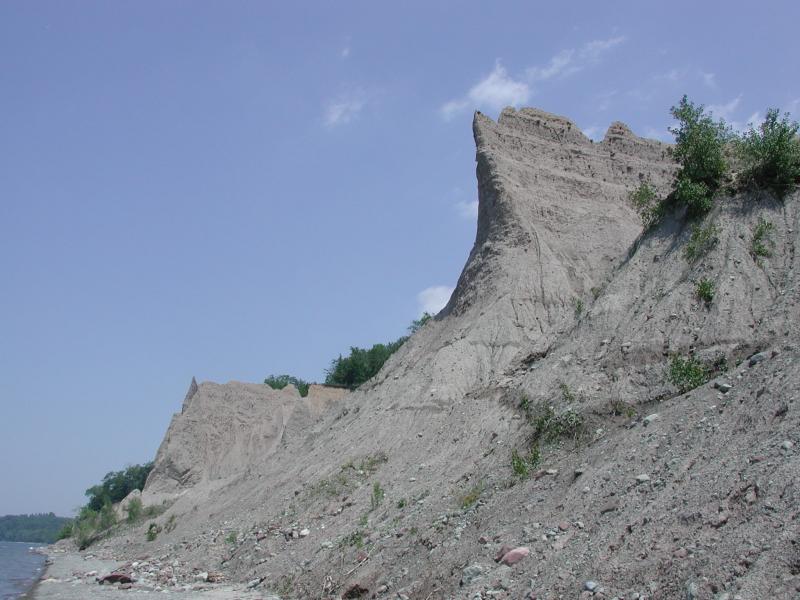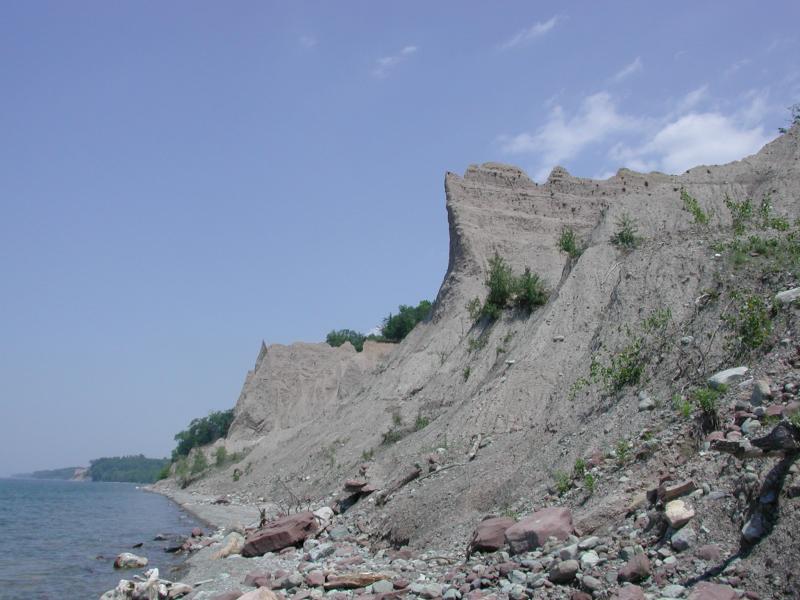Great Lakes Bluff
- System
- Terrestrial
- Subsystem
- Open Uplands
- State Protection
- Not Listed
Not listed or protected by New York State.
- Federal Protection
- Not Listed
- State Conservation Status Rank
- S1
Critically Imperiled in New York - Especially vulnerable to disappearing from New York due to extreme rarity or other factors; typically 5 or fewer populations or locations in New York, very few individuals, very restricted range, very few remaining acres (or miles of stream), and/or very steep declines.
- Global Conservation Status Rank
- G4
Apparently Secure globally - Uncommon in the world but not rare; usually widespread, but may be rare in some parts of its range; possibly some cause for long-term concern due to declines or other factors.
Summary
Did you know?
You can see 150 foot tall "chimneys" made of small stone, gravel, sand, and clay at Chimney Bluffs State Park. These eroding drumlins have existed for thousands of years and are constantly changing from exposure to Great Lakes erosional forces, such as water, ice, or wind.
State Ranking Justification
There are an estimated 5 to 30 extant occurrences statewide. Three currently documented occurrences are mostly protected on state park land. Great Lakes bluffs appear to be restricted to the drumlin region of the Great Lakes Plain Ecozone. The bluffs form in areas where drumlins are positioned along the south shore of Lake Ontario. The overall trend for the community is suspected to be slightly declining due to recreational overuse, erosion prevention activities, and other development.
Short-term Trends
The number and size of Great Lakes bluffs in New York appear to be stable, or perhaps declining slightly, in recent years.
Long-term Trends
It is likely that Great Lakes bluffs were never widespread and common in New York given their physiogeographic setting (i.e., drumlins on the Lake Ontario shoreline). The number of Great Lakes bluffs in New York may have declined slightly from historical numbers and their aerial extent and viability are suspected to have declined over the long-term. These declines are likely correlated with coastal development and associated changes in connectivity, hydrological alteration, and natural erosion processes.
Conservation and Management
Threats
The threats to Great Lakes bluffs in New York include invasive plants (mostly non-native, successional old field weeds), recreational overuse; specifically, off-trail hiking. Additional threats include fragmentation of bluffs for beach access. Broad threats to Great Lakes shoreline include shoreline fragmentation, and management practices like shoreline hardening/erosion prevention.
Conservation Strategies and Management Practices
Maintain the dominant ecological processes responsible for keeping this dynamic community in disclimax. Natural disturbances, including wave erosion and strong offshore winds, should be expected to lead to slumping, gully forming, and bluff retreat. Prevent recreational overuse and encourage the public to stay on marked trails. Because the face of the bluffs can be expected to migrate inland, it is important to protect adequate open space to accommodate such change. Prevent the spread of invasive exotic species into the bluffs through appropriate direct management and by minimizing potential dispersal corridors, such as beach access trails and stairways.
Development and Mitigation Considerations
Development should avoid fragmentation ofth bluffs to allow for seed dispersal and seasonal animal migrations. Bisecting trails, roads, and developments can also allow exotic plant and animal species to invade. Connectivity to the lake and to should be maintained to maintain Great Lakes processes, such offshore winds and lake effect precipitation. Natural community buffers should be maintained or restored landward behind the bluffs to allow for bluff retreat in the future.
Inventory Needs
Releve plots are needed from known occurrences and searches for new occurrencs are needed.
Research Needs
A study could investigate the effects of lake level (artificial vs. historic natural) on the dynamic erosive processes of this community.
Rare Species
Range
New York State Distribution
In New York, Great Lakes bluffs are known from the drumlin region of the Great Lakes Plain ecozone. Currently documented occurrences are known from Chimney Bluffs State Park in Wayne County, Fair Haven Beach State Park in Cayuga County, and Hamlin Beach State Park in Monroe County.
Global Distribution
The distribution of Great Lakes bluffs similar to those in New York is uncertain. Cliff communties comprised of various consolidated bedrock are known from across the Great Lakes region. However, more research and inventory is needed to confirm the distribution of bluffs comprised of unconsolidated material of drumlins beyond New York.
Best Places to See
- Hamlin Beach State Park (Monroe County)
- Chimney Bluffs State Park (Wayne County)
- Fair Haven Beach State Park
Identification Comments
General Description
A sparsely vegetated community that occurs on vertical exposures of unconsolidated material, such as small stone, gravel, sand, and clay, that is exposed to Great Lakes erosional forces, such as water, ice, or wind. There are very few woody species present because of the unstable substrate. Most abundant species are usually annual and early succesional herbs.
Characters Most Useful for Identification
Great Lakes bluffs are adjacent to one of the Great Lakes and are exposed to their erosional forces. The most abundant species are usually annual and early succesional herbs.
Elevation Range
Known examples of this community have been found at elevations between 245 feet and 400 feet.
Best Time to See
Great Lakes bluffs are an impressive site to see year round.
Great Lakes Bluff Images
Classification
Characteristic Species
-
Trees > 5m
- Acer rubrum var. rubrum (common red maple)
- Acer saccharum (sugar maple)
- Betula alleghaniensis (yellow birch)
- Betula papyrifera (paper birch)
- Fraxinus americana (white ash)
- Ostrya virginiana (hop hornbeam, ironwood)
- Populus deltoides ssp. deltoides (eastern cottonwood)
- Populus tremuloides (trembling aspen, quaking aspen)
-
Shrubs 2 - 5m
- Acer negundo var. negundo (box-elder, ash-leaved maple)
- Acer saccharum (sugar maple)
- Betula alleghaniensis (yellow birch)
- Betula papyrifera (paper birch)
- Ostrya virginiana (hop hornbeam, ironwood)
- Populus deltoides ssp. deltoides (eastern cottonwood)
- Populus tremuloides (trembling aspen, quaking aspen)
- Quercus rubra (northern red oak)
- Robinia pseudoacacia (black locust)
- Tilia americana var. americana (American basswood)
-
Shrubs < 2m
- Acer saccharum (sugar maple)
- Betula alleghaniensis (yellow birch)
- Betula papyrifera (paper birch)
- Cornus sericea (red-osier dogwood)
- Elaeagnus umbellata (autumn-olive)
- Fraxinus americana (white ash)
- Lonicera morrowii (Morrow's honeysuckle)
- Populus deltoides ssp. deltoides (eastern cottonwood)
- Populus tremuloides (trembling aspen, quaking aspen)
- Robinia pseudoacacia (black locust)
- Rubus allegheniensis (common blackberry)
- Rubus idaeus ssp. strigosus (American red raspberry)
- Rubus odoratus (purple-flowering raspberry)
- Salix spp.
-
Vines
- Toxicodendron radicans ssp. radicans (eastern poison-ivy)
- Vitis riparia (river grape, frost grape)
-
Herbs
- Achillea millefolium (yarrow)
- Agrostis gigantea (red-top)
- Anthoxanthum odoratum (sweet vernal grass)
- Arisaema triphyllum ssp. triphyllum (common jack-in-the-pulpit)
- Artemisia vulgaris (mugwort)
- Carex pedunculata ssp. pedunculata (long-stalked sedge)
- Centaurea stoebe ssp. micranthos (spotted knapweed)
- Cichorium intybus (chicory)
- Daucus carota (wild carrot)
- Elymus canadensis var. canadensis (Canada wild-rye)
- Equisetum arvense (field horsetail, common horsetail)
- Erigeron annuus (annual daisy fleabane)
- Eurybia divaricata (white wood-aster)
- Festuca subverticillata (nodding fescue)
- Fragaria virginiana ssp. virginiana (common wild strawberry)
- Hypericum perforatum ssp. perforatum (common St. John's-wort)
- Juncus tenuis (path rush)
- Leucanthemum vulgare (ox-eye daisy)
- Maianthemum racemosum ssp. racemosum (false Solomon's-seal)
- Melilotus albus (white sweet-clover)
- Oenothera biennis (common evening-primrose)
- Poa compressa (flat-stemmed blue grass, Canada blue grass)
- Prunella vulgaris ssp. vulgaris (Eurasian self-heal, Eurasian heal-all)
- Solidago canadensis var. canadensis (Canada goldenrod)
- Trifolium spp.
- Tussilago farfara (colts-foot)
Similar Ecological Communities
- Cliff community
(guide)
While both community are sparsely vegetated and very steep, cliff communities form on consolidated bedrock outcrops, and Great Lakes bluffs form on unconsolidated material, such as small stone, gravel, sand, and clay (e.g., drumlins).
- Maritime bluff
(guide)
While both communities are types of erosional cliffs comprised of unconsolidated material, maritime bluffs are located on moraines along the Atlantic Ocean coast, and Great Lakes bluffs are found on drumlins on Lake Ontario.
Vegetation
Percent cover
This figure helps visualize the structure and "look" or "feel" of a typical Great Lakes Bluff. Each bar represents the amount of "coverage" for all the species growing at that height. Because layers overlap (shrubs may grow under trees, for example), the shaded regions can add up to more than 100%.
Additional Resources
References
Edinger, G. J., D. J. Evans, S. Gebauer, T. G. Howard, D. M. Hunt, and A. M. Olivero (editors). 2014. Ecological Communities of New York State. Second Edition. A revised and expanded edition of Carol Reschke’s Ecological Communities of New York State. New York Natural Heritage Program, New York State Department of Environmental Conservation, Albany, NY. https://www.nynhp.org/ecological-communities/
Edinger, Gregory J., D.J. Evans, Shane Gebauer, Timothy G. Howard, David M. Hunt, and Adele M. Olivero (editors). 2002. Ecological Communities of New York State. Second Edition. A revised and expanded edition of Carol Reschke's Ecological Communities of New York State. (Draft for review). New York Natural Heritage Program, New York State Department of Environmental Conservation. Albany, NY. 136 pp.
Larson, D.W., U. Matthes, and P.E. Kelly. 2000. Cliff Ecology: Pattern and Process in Cliff Ecosystems. Cambridge University Press, New York, New York.
New York Natural Heritage Program. 2024. New York Natural Heritage Program Databases. Albany, NY.
Van Diver, Bradford B. 1985. Roadside Geology of New York. Mountain Press Publishing Company, Missoula, MT.
Links
About This Guide
This guide was authored by: Gregory J. Edinger
Information for this guide was last updated on: November 3, 2023
Please cite this page as:
New York Natural Heritage Program. 2024.
Online Conservation Guide for
Great Lakes bluff.
Available from: https://guides.nynhp.org/great-lakes-bluff/.
Accessed July 26, 2024.

